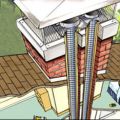CHIMNEY REPAIR
Whoever thought that you might need chimney repair because of bricks that are spalled? Aspalled brick is one that is broken. It’s the surface damage of a brick.
Because of its heat-containing features, only fire-treated brick may be used internally. External brickwork is different.Brick is a common building component, but brick mechanics change according to use, location, and the exposure to the elements. A qualified brick mason must know many things.
Brick deteriorates. Old brick with many years of exposure to weather may “flake.” Exterior surfaces will peel away from the brick, while constant exposure to the elementsmay cause a brick to fail, crack, and fallaway from the chimney.The greatest source of damage to the chimney is water—freezing and thawing.
Bricks used in chimney exteriors are developed with porous interiors and finished with a hard nonporous shell. Whenever that shell is breached, the porous interior of the brick becomes exposed to the elements. Water in the cracks of a brick freezes, forcing bricks to split. In a lined chimney, the exterior brick will split away from the liner and may fall to the roof or the ground. Once water has found its way inside a brick wall, the freeze-thaw-freeze process will progressively destroy the wall—or the exterior of a chimney.
But Also the Mortar
There are five types of mortar: M, N, S, O, and K. These vary according to the amount of cement, water, sand, and hydrated lime included. The names are designated by the American Society for Testing and Development (ASTD). They vary according to the pressure the masonry wall must endure. Type M is the mortar for chimney brickwork. It is a high-strength mortar.
By its nature, mortar is designed to be elastic. Brickwork can experience minor shifting. The mortar will permit that, while maintaining the bonding. This will affect how much mortar is applied, as the brick could be “squeezed,” should too much mortar be used. Squeezing will also lead to cracks and subsequent deterioration.
Back to Spalling
One type of spalling that applies to brickwork is known as mechanical spalling, and it occurs in one of two manners:
• High stress contact: something applied as pressure against the brickwork itself, such as a pressure washing. When the under-surface construction of the brick gives way, the outside of the brick splits off.
• Cavitation can also cause spalling. Fluids will aggregate inside the brick, causing bubbles to form. The bubbles expand, blowing the brick apart.
Again, the freeze/dry cycle can cause the spalling, plus changes in load, thermal expansion, and exposure to salt. Damage is possible in wind stress and ambient heat situations and where there is great exposure to salt, such as the seashore.
Possible Solutions
Now that you know what it is, what can be done about it? That lies in one of two actions:
• Replacing damaged bricks
• Repointing crumbling mortar
For proper chimney repair, brick replacement must be done slowly. The mason must remove the damaged bricks in a manner that isolates the bad brick(s) without collapsing the rest of the chimney. This will mean cutting bricks to fit and size adjustments made to fit the aesthetics of the chimney.Mortar around the damaged brick must be removed to at least a depth of ½ inch and the surface must be wire brushed.
Type M mortar will be used, and in small amounts, that it may not dry before being applied. Add water, apply mortar to the empty space, trowel it onto the surfaces of the replacement brick, and insert it. Scrape away any excess mortar and shape the mortar to where it looks like the surrounding mortar.
Repointing is the other option for chimney repair. Where the mortar is crumbling, the mason will clear it with a hammer and cold chisel, brushing it clean with a wire brush.
The mason will load a mortar bag, allowing for the direction of new mortar into the deficient space until it has been completely filled. Once he has removed any excess mortar and shaped the joint so it looks like an adjacent joint, the process is complete.
For More Information About Chimney repair Visit Us.
SDource: Click Here




